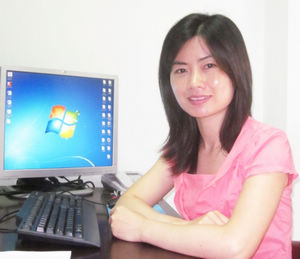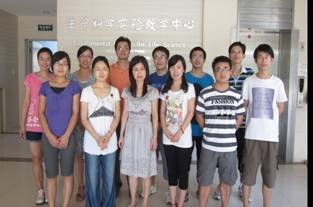Microbiology and Immunology
 | Yuping Lai, Ph.D |
| Professor of Microbiology and Immunology | |
| Shanghai Key Laboratory of Regulatory Biology | |
| School of Life Sciences | |
| East China Normal University | |
| Tel: 86-21-54342908 | |
| Fax: 86-21-54342908 | |
| Email: yplai@bio.ecnu.edu.cn |
Dr. Yuping Lai received her Ph.D degree from East China Normal University in 2006. After graduate school, which included an NIH/NIAID predoctoral fellowship, Yuping moved to Gallo’s lab in University of California-San Diego and began to investigate the relationships between microbes and their hosts, especially how Staphylococcus epidermidis influences skin immune responses. After her postdocotoral training, Yuping moved back to China and started her own laboratory in East China Normal University in January 2010. Now her research interests are focused on understanding innate immune responses involved in wound infection, inflammation and wound healing.
Past two years, Yuping has published 7 papers and got multiple grants including grants from National Natural Science Foundation of China, Science and Technology Commission of Shanghai Municipality and so on. She also has been awarded as the “Eastern Scholar” and “New Century Excellent Talents in University”.
Members of Yuping’s Group
 | Meiling Zhang,Associate professor |
| Deming Jiang, Instructor | |
| Yelin Wu, Instructor | |
| Ph.D candidates: Dongqing Li, Ziwei Jiang, Changwei Li, Yanchun Quan | |
| Other graduate students: Hu Lei, Zhiheng Li, Tian Zhang, Yue Wang, Hongquan Li, Kewei Li, Xiaoli Xia, Xiaoguang Gao, yuanqi Liu. |
Research Interests
Our research interests are focused on wound infection, inflammation and wound healing, including:
(1) To define the functions of REG3A in wound healing and psoriasis and explore the mechanisms by which REG3A regulate keratinocyte proliferation and differentiation.
(2) To investigate the functions of lipopeptides from skin commensal bacterium Staphylococcus epidermidis in skin inflammation and the mechanisms by which lipopeptides regulate inflammatory responses in wounds and atopic dermatitis.
(3) To understand the relationships between host defense and microbes, especially how IL-33 expressed by macrophages regulate innate antimicrobial defense against Staphylococcus aureus infection.
Grants
| Project Number | Title | Sources | Amount | Period |
| 31222021 | Skin Immunology | National Natural Science Foundation | 1,000,000 | 2013-2015 |
| 81072422 | Skin commensals regulate TLRs to induce antimicrobial peptides against microbial infections | National Natural Science Foundation | 310,000 | 2011-2013 |
| 31170867 | The mechanisms by which IL-17A regulates REG3A to promote wound healing | National Natural Science Foundation | 600,000 | 2012-2015 |
| 11QA1401900 | The mechanisms by which RegIII-gamma protects against infection in wounds | Science and Technology Commission of Shanghai Municipality | 150,000 | 2011-2013 |
| 12ZZ039 | The mechanisms by which REG3A regulates TLR3-dependent inflammation in wounds | Innovation Program of Shanghai Municipal Education Commission | 160,000 | 2012-2013 |
| SG0173 | S.epidermidis-related molecules which mediate inflammation and enhance AMP function | Johnson & Johnson Pte Ltd. | 1,310,000 | 2010-2014 |
Awards and Honors:
2012.2 New Century Excellent Talents in University
2011.11 Professor of special appointment (Eastern Scholar) at Shanghai Institutions of Higher Learning
2009.2 Albert M. Kligman Travel Fellowship
2007.12 Outstanding Ph.D dissertation in Shanghai, China
2006.5 Outstanding graduate research at the National Institutes of Health (NIH)
2005-2006 Graduate Partnerships Program Fellowship (NIAID, NIH)
Patents:
1. Gallo RL, Nizet V, Cogen A, Lai Y. Antimicrobial and anti-inflammatory therapies and compositions. U.S.A. Patent No. US2010/0166708A1.
2. Otto M, Li M, Lai Y, Villaruz AE, Cha DJ, Sturdevant DE. Gram-positive three-component antimicrobial peptide-sensing system. U.S.A. patent. Application No.60/930,709.
3. Lai, Y-P, Wu, Z.-R. etc. Method for construction of Dermcidin-1L high expression plasmid and the applications of Dermcidin-1L. Chinese patent. Patent number: ZL200510023674.4.
Oral Presentations:
2008. 10 American Society for Microbiology conference, beneficial microbes (San Diego, USA)
2009. 5 Plenary session in 2009 Society for Investigative Dermatology Annual Meeting (Montreal, Canada)
2009.11 Johnson & Johnson Skin Research Center, CPPW, a Unit of Johnson & Johnson Consumer Companies, Inc-Invited speaker ( Skillman, U.S.A.)
2010.5 Johnson & Johnson China Ltd. Worldwide EM Innovation Center -Invited speaker (Shanghai, China)
2010.10 Chinese Microbiology annual meeting (Huangshan, China)
2011.9 Cold Spring Harbor Asia Infection & Immunity (Suzhou, China)
2012.5 2012 Society for Investigative Dermatology Annual Meeting (Raleigh, U.S.A.)
2012.9 Cold Spring Harbor Asia Frontiers of Immunology in Health and Diseases (Suzhou, China)
Publications:
Reviews:
1. Leichtle A, Lai Y, Wollenberg B, Wasserman SI, Ryan AF. Innate signaling in otitis media: pathogenesis and recovery. Curr Allergy Asthma Rep. 2011, 11(1): 78-84.
2. Lai Y, Gallo RL. Commensal skin bacteria as the probiotic of the cutaneous immune response. Expert Rev. Dermatol. Editorial. 2010, 5(3): 251-253.
3. Lai Y, Gallo RL. AMPed up immunity: how antimicrobial peptides have multiple roles in immune defense. Trends in Immunology. Feature Review. 2009, 30(3): 131-141.
4. Lai Y, Gallo RL. Toll-like receptors in skin infections and inflammatory diseases. Infectious Disorders Drug Targets (Formerly 'Current Drug Targets - Infectious Disorders'). 2008, 8(3): 144-155.
Original Articles:
1. *Lai Y, Li D, Li C, Muhleisen B, Radek KA, Park HJ, Jiang Z, Li Z, Lei H, Quan Y, Zhang T, Wu Y, Kotol P, Morizane S, Hata TR, Iwatsuki K, Tang C, Gallo RL. The antimicrobial protein REG3A regulates keratinocyte proliferation and differentiation after skin injury. Immunity. Accepted. (* Corresponding author)
2. Lai Y, Cogen AL, Radek KA, Park, HJ, Macleod DT, Leichtle A, Ryan AF, Di Nardo A, Gallo RL. Activation of TLR2 by a small molecule produced by Staphylococcus epidermidis increases antimicrobial defense against bacterial skin infections. Journal of Investigative Dermatology. 2010, 130(9):2211-2221.
3. Lai Y, Di Nardo A, Nakatsuji T, Leichtle A, Yang Y, Cogen AL, Wu Z-R, Hooper LV, Schmidt RR, von Aulock S, Radek KA, Huang C-M, Ryan AF, Gallo RL. Commensal bacteria regulate TLR3-dependent inflammation after skin injury. Nature Medicine. Covey Story. 2009, 15(12): 1377-1382.
4. Li M, Lai Y, Villaruz AE, Cha DJ, Sturdevant DE, Otto M. Gram-positive three-component antimicrobial peptide-sensing system. Proc Natl Acad Sci U S A. 2007, 104(22):9469-9474 (Co-first author).
5. Lai Y, Villaruz AE, Li M., Cha DJ, Sturdevant DE, Otto M. The human anionic antimicrobial peptide dermcidin induces proteolytic defence mechanisms in staphylococci. Molecular Microbiology. 2007, 63(2):497-506.
6. Lai YP, Peng YF, Zuo Y, Li J, Huang J, Wang LF, Wu ZR. Functional and structural characterization of recombinant dermcidin-1L, a human antimicrobial peptide. Biochemical and Biophysical Research Communications. 2005, 328(1):243-250.
7. Lai YP, Huang J, Wang LF, Li J, Wu ZR. A new approach to random mutagenesis in vitro. Biotechnology and Bioengineering. 2004, 86(6): 622-627.
8. Lai YP, Peng YF, Yu ZY, Huang J, Wu ZR. Cloning and expression of DCD-1L in Pichia pastoris. China Biotechnology. 2004, 2: 61-65.
9. Wang Z, Lai Y, Bernard JJ, Macleod DT, Cogen AL, Moss B, Di Nardo A. Skin Mast Cells Protect Mice against Vaccinia Virus by Triggering Mast Cell Receptor S1PR2 and Releasing Antimicrobial Peptides. J Immunol. 2012, 188(1):345-357.
10. Wu YL, Huang J, Xu J, Liu J, Feng Z, Wang Y, Lai Y*, Wu ZR*. Addition of a cysteine to glucagon-like peptide-1 (GLP-1) conjugates GLP-1 to albumin in serum and prolongs GLP-1 action in vivo. Regulatory Peptides. 2010, 164(2-3):83-89. (*Co-corresponding author)
11. Feng Z, Lai Y, Ye H, Huang J, Xi XG, Wu Z. Poly (gamma, L-glutamic acid)-cisplatin bioconjugate exhibits potent antitumor activity with low toxicity: A comparative study with clinically used platinum derivatives. Cancer Science. 2010, 101(11): 2476-2482.
12. Leichtle A, Hernandez M, Ebmeyer J, Yamasaki K, Lai Y, Radek K, Choung YH, Euteneuer S, Pak K, Gallo R, Wasserman SI, Ryan AF. CC chemokine ligand 3 overcomes the bacteriocidal and phagocytic defect of macrophages and hastens recovery from experimental otitis media in TNF-/- mice. J Immunology. 2010, 184(6): 3087-3097.
13. Cogen AL, Yamasaki K, Muto J, Sanchez KM, Crotty Alexander L, Tanios J, Lai Y, Kim JE, Nizet V, Gallo RL. Staphylococcus epidermidis antimicrobial delta-toxin (phenol-soluble modulin-gamma) cooperates with host antimicrobial peptides to kill group A Streptococcus. PLoS One. 2010, 5(1): e8557.
14. Cogen AL, Yamasaki K, Sanchez KM, Dorschner RA, Lai Y, Macleod DT, Torpey JW, Otto M, Nizet V, Kim JE, Gallo RL. Selective antimicrobial action is provided by phenol-soluble modulins derived from Staphylococcus epidermidis, a normal resident of the skin. Journal of Investigative Dermatology. 2010, 130(1): 192-200.
15. Li M, Rigby K, Lai Y, Nair V, Peschel A, Schittek B, Otto M. Staphylococcus aureus mutant screen reveals the interaction of human antimicrobial peptide dermcidin with membrane phospholipids. Antimicrobial Agents Chemotherapy. 2009, 53(10):4200-4210.
16. Di Nardo A, Yamasaki K, Dorschner RA, Lai Y, Gallo RL. Mast cell cathelicidin antimicrobial peptide prevents invasive group A Streptococcus infection of the skin. Journal of Immunology. 2008, 180(11):7565-7573.
17. Li M, Cha DJ, Lai Y, Villaruz AE, Sturdevant DE, Otto M. The antimicrobial peptide-sensing system aps of Staphylococcus aureus. Molecular Microbiology. 2007, 66(5): 1136-1147.
18. Yao Y, Vuong C, Kocianva S, Villaruz AE, Lai Y, Sturdevant DE, Otto M. Characterization of the Staphylococcus epidermidis accessory gene regulator response: quorum-sensing regulation of resistance to innate host defense. The Journal of Infectious Diseases. 2006, 193(6):841-848.


